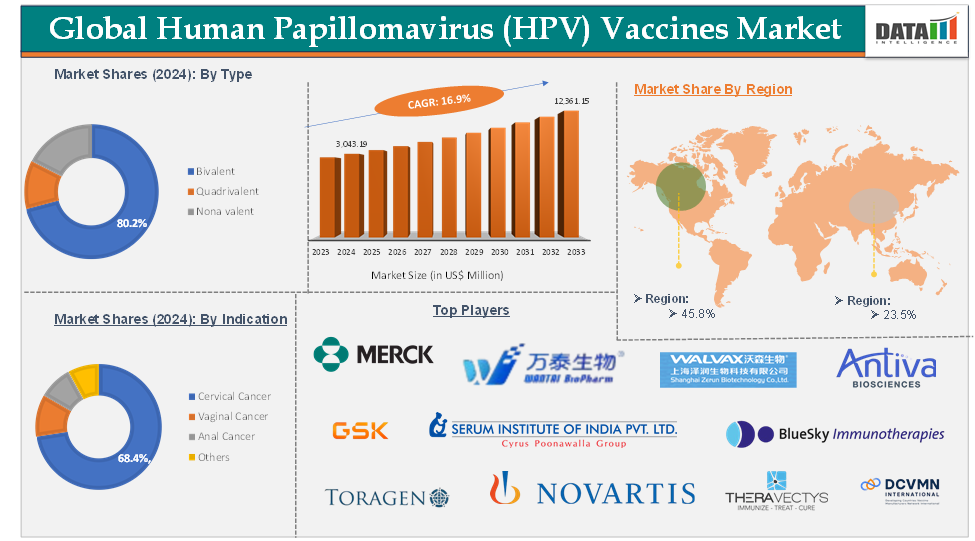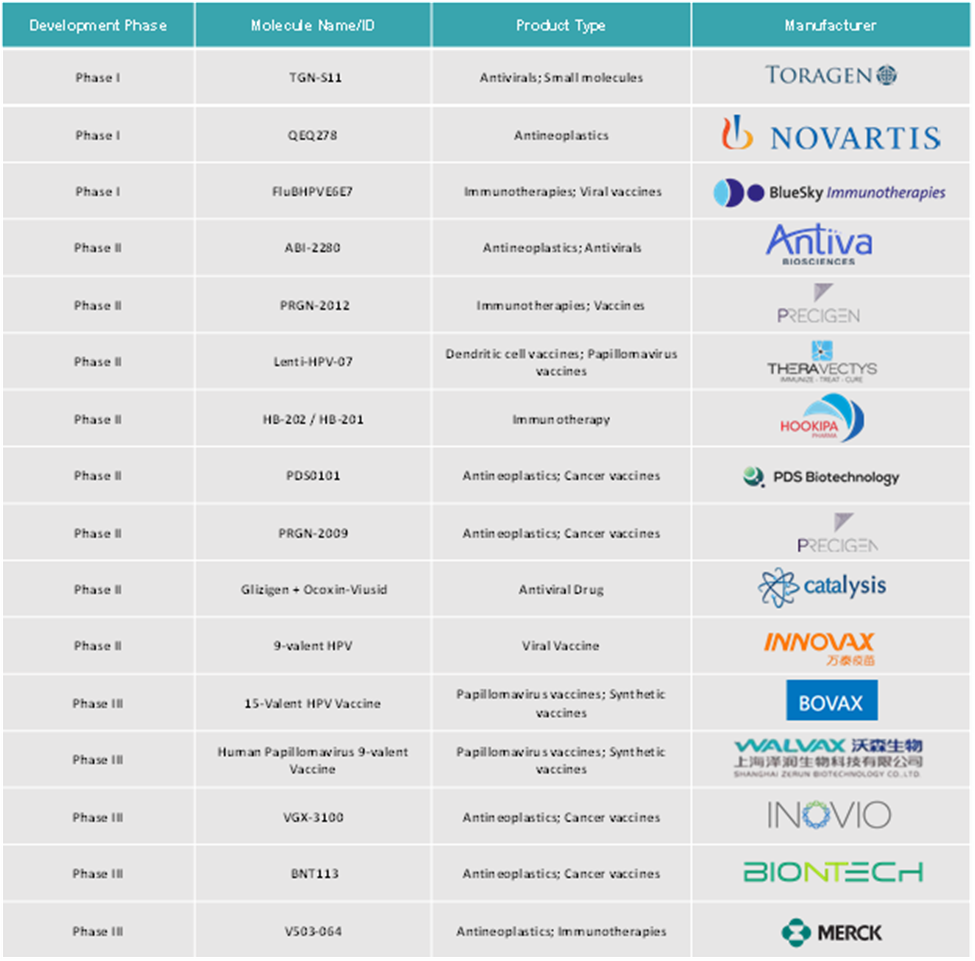Global Human Papillomavirus (HPV) Vaccines Market – Industry Trends & Outlook
HPV vaccines protect against infection with human papillomaviruses (HPV), a group of over 200 related viruses, more than 40 of which are transmitted through direct sexual contact. Among these, two types are responsible for genital warts, while about a dozen high-risk types can lead to cancers such as cervical, anal, oropharyngeal, penile, vulvar, and vaginal cancers.
Key drivers fueling market growth are the rising burden of HPV-related cancers, strong governmental and international support for vaccination, improved vaccine accessibility, and growing investments from pharmaceutical companies. Opportunities abound in emerging markets, the introduction of new vaccine formulations, and integration with broader adolescent health initiatives.
The scope of the market encompasses bivalent, tetravalent, and nonavalent vaccines, targeting prevention of cervical, anal, vulvar, vaginal, penile, and oropharyngeal cancers. North America continues to dominate the market, holding nearly half of the global share, while the Asia-Pacific region is poised for the fastest growth due to rising HPV-related cancer incidence and expanding immunization programs.
Industry outlook is optimistic, driven by increasing disease awareness, government initiatives, and global health partnerships. Trends shaping the market include innovation in adjuvant technology, expanded focus on immunocompromised and LGBTQ+ populations, integration of vaccination with cancer screening, and the rise of community-based education programs.
Market insights highlight the rapid scale-up of both supply and demand, particularly in underserved regions, and the central role of HPV vaccination in comprehensive cancer control strategies. Industry reports consistently emphasize the importance of health equity, vaccine equity, and market-shaping efforts by organizations like Gavi, UNICEF, and WHO to improve supply, pricing, and access globally. Overall, the HPV vaccines market is set for sustained, impactful growth, underpinned by innovation, policy support, and a global commitment to reducing HPV-related disease burden.
Global Human Papillomavirus (HPV) Vaccines Market - Executive Summary

Global Human Papillomavirus (HPV) Vaccines Market Dynamics: Drivers & Restraints
Rising Prevalence of Cervical Cancer
The rising prevalence of cervical cancer-now the fourth most common cancer in women globally, as per World Health Organization (WHO) data in March 2024, with around 660,000 new cases and 350,000 deaths in 2022-is a powerful driver for growth in the global human papillomavirus (HPV) vaccines market. This burden is especially acute in low- and middle-income countries (LMICs), which account for about 94% of cervical cancer deaths, and in regions such as sub-Saharan Africa, Central America, and South-East Asia, where incidence and mortality rates are highest.
The high incidence and mortality rates of cervical cancer, particularly in LMICs, have heightened awareness among governments, health organizations, and the public about the need for effective prevention. This has led to greater prioritization of HPV vaccination as a public health strategy. Countries with the highest cervical cancer rates-such as those in sub-Saharan Africa and South-East Asia-are increasingly introducing or scaling up HPV vaccination programs. As more LMICs add HPV vaccines to their national immunization schedules, the market for these vaccines continues to expand.
Accessibility and Supply Chain Issues
Accessibility and supply chain challenges have been persistent restraints in the global human papillomavirus (HPV) vaccines market, particularly impacting low- and middle-income countries (LMICs) where the burden of HPV-related diseases is highest.
Rapid increases in demand, driven by expanded vaccination programs, have outpaced manufacturers’ ability to scale up production, presenting extraordinary challenges for timely supply. Technology transfers to expand global manufacturing capacity have been limited, and the process of bringing new suppliers to market with WHO-prequalified products is slow.
Accessibility and supply chain issues have significantly limited the reach and impact of HPV vaccination programs worldwide. Addressing these barriers through increased manufacturing capacity, diversified suppliers, improved logistics, and sustained funding remains critical for achieving global cervical cancer prevention goals.
For more details on this report, Request for Sample
Global Human Papillomavirus (HPV) Vaccines Market - Pipeline Analysis
Top Phase Pipeline Products for Human Papillomavirus (HPV):

Global Human Papillomavirus (HPV) Vaccines Market - Segment Analysis
The global human papillomavirus (HPV) vaccine market is segmented based on type, gender, age group, indication, and region.
Indication:
The cervical cancer segment was valued at US$ 1,668.33 million in 2024 and is estimated to reach US$ 6,469.87 million by 2033, growing at a CAGR of 14.4% during the forecast period from 2025-2033
Human papillomavirus (HPV) is a highly prevalent sexually transmitted virus, infecting over 80% of individuals by age 45. While most HPV infections are asymptomatic, the virus is responsible for a range of cancers, most notably the majority of cervical cancer. As per World Health Organization (WHO) data in 2022, there were an estimated 661,000 new cases of cervical cancer and more than 348,000 related deaths worldwide, making it the fourth leading cause of both cancer incidence and mortality among women. More than 90% of cervical cancer deaths occur in low- and middle-income countries, highlighting significant global health disparities.
This segment is the primary focus of national immunization programs and global health initiatives such as those led by the World Health Organization (WHO), GAVI, and UNICEF, which prioritize vaccination of adolescent girls to prevent cervical cancer.
The high disease burden, especially in low- and middle-income countries (LMICs) where regular screening is limited, further intensifies the demand for prophylactic HPV vaccines. Additionally, increasing awareness, inclusion of HPV vaccines in school-based immunization programs, and the growing availability of low-cost domestic vaccines from manufacturers in India and China have accelerated market penetration.
Technological advancements and the introduction of nonavalent vaccines with broader strain coverage have also contributed to improved protection against cervical cancer and its associated precancerous lesions, strengthening the growth trajectory of this segment globally.
Global Human Papillomavirus (HPV) Vaccines Market - Geographical Analysis
The North America human papillomavirus (HPV) vaccine market was valued at US$ 1,143.64 million in 2024 and is estimated to reach US$ 4,819.32 million by 2033, growing at a CAGR of 15.3% during the forecast period from 2025-2033
The North America human papillomavirus (HPV) vaccines market is driven by several key factors that collectively support its growth and leadership in the global landscape. A primary driver is the high burden of HPV-related cancers, including cervical, anal, and oropharyngeal cancers, which has heightened the urgency for preventive measures across the region.
Robust healthcare infrastructure and widespread access to medical services enable early screening and efficient vaccine delivery, while strong governmental and public health initiatives-such as school-based vaccination programs and awareness campaigns-have significantly increased vaccine uptake.
Additionally, frequent product launches, regulatory approvals, and expanded indications by leading market players-such as the approval of Gardasil 9 for broader age groups-promote market expansion and accessibility.
Investments in research and development, a favorable regulatory environment, and strategic collaborations between public and private sectors also contribute to the market’s growth and resilience. Collectively, these drivers ensure that North America remains at the forefront of HPV vaccine adoption and innovation, supporting ongoing efforts to reduce the incidence and mortality of HPV-related diseases.
The Asia-Pacific human papillomavirus (HPV) vaccine market was valued at US$ 605.23 million in 2024 and is estimated to reach US$ 3,292.92 million by 2033, growing at a CAGR of 18.3% during the forecast period from 2025-2033
The Asia-Pacific HPV vaccines market is one of the fastest-growing regions globally. It includes major countries such as Japan, China, India, South Korea, Australia, and Southeast Asian nations. The market is driven by rising awareness, government initiatives, and the increasing incidence of HPV-related cancers.
The incidence of cervical and other HPV-related cancers is increasing in Asia-Pacific, especially in countries with large populations like India and China. Japan has a significant focus on cervical cancer prevention due to its public health impact.
Many governments (including Japan, Australia, and China) have launched or expanded national immunization programs for HPV vaccination. Subsidies and school-based vaccination campaigns are boosting coverage.
Japan is a major market in the region. After a period of suspended recommendations, the government resumed proactive HPV vaccination in 2022, leading to a surge in vaccination rates. Japan’s robust healthcare infrastructure and public health policies are expected to further drive market growth.
Global Human Papillomavirus (HPV) Vaccines Market - Competitive Landscape (Major Players)
Top companies in the human papillomavirus (HPV) vaccine market include Merck & Co., Inc., GSK plc, Wantai BioPharm., Walvax Biotechnology Co., Ltd., Serum Institute of India Pvt. Ltd., and Jiangsu Recbio Technology Co., Ltd., among others.
Global Human Papillomavirus (HPV) Vaccines Market - Competitive Landscape (Emerging Players)
Emerging companies in the human papillomavirus (HPV) vaccine market include DCVMN International, Shanghai Zerun Biotech Co., Ltd., Shanghai Bovax Biotechnology Co., Ltd., Jiangsu Recbio Technology Co., Ltd., Toragen, BlueSky Immunotherapies, Antiva Biosciences, Precigen, INOVIO Pharmaceuticals, and BioNTech SE, among others.
Global Human Papillomavirus (HPV) Vaccines Market - Scope
| Metrics | Details | |
| CAGR | 16.9% | |
| Market Size Available for Years | 2022-2033 | |
| Estimation Forecast Period | 2025-2033 | |
| Revenue Units | Value (US$ Mn) | |
| Segments Covered | Type | Bivalent, Quadrivalent, Nona valent |
| Gender | Female, Male | |
| Age Group | Children, Adults | |
| Indication | Cervical Cancer, Vaginal Cancer, Anal Cancer, Others | |
| Regions Covered | North America, Europe, Asia-Pacific, South America, and the Middle East & Africa | |

